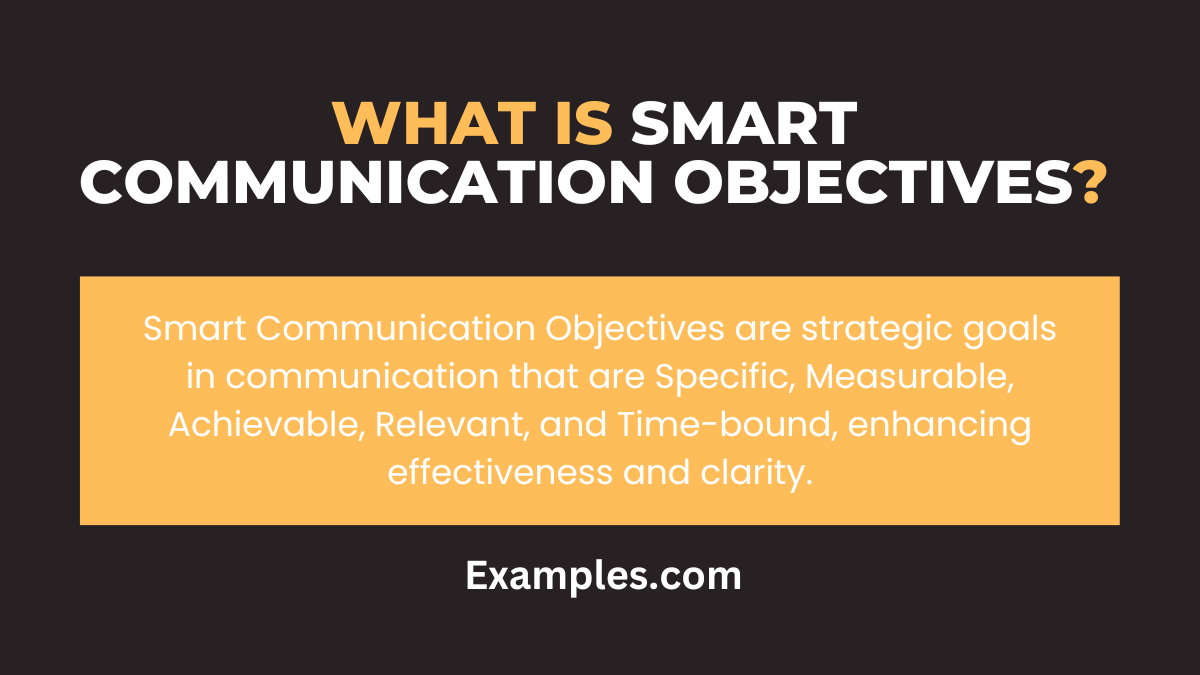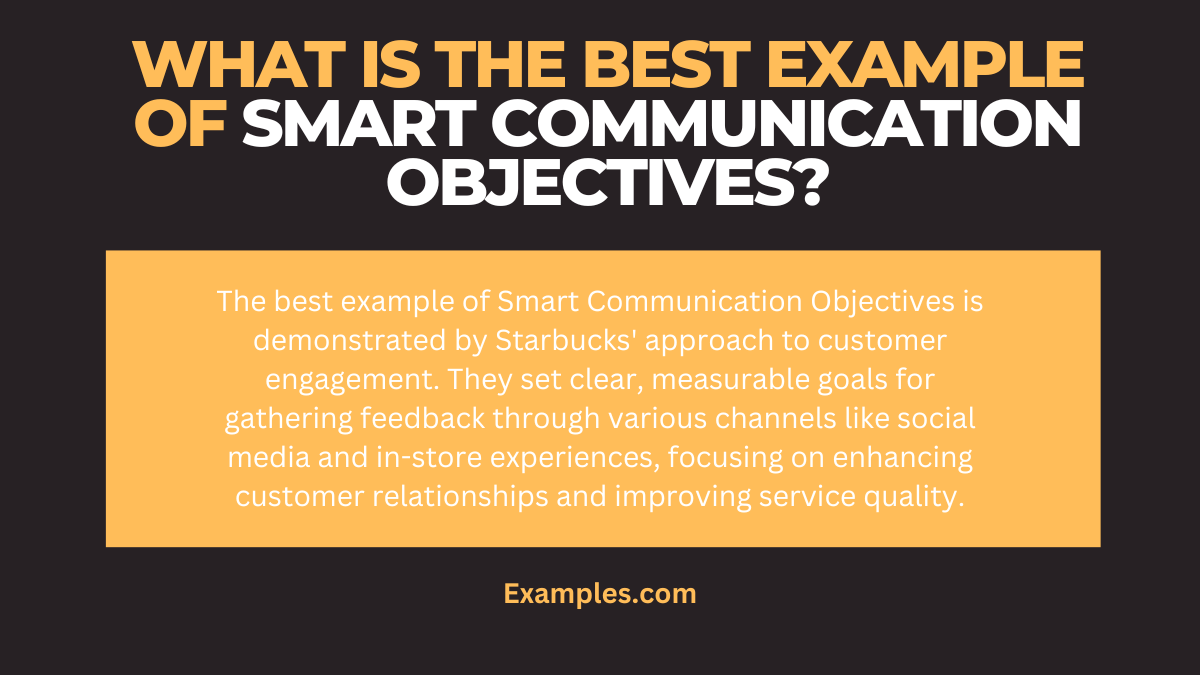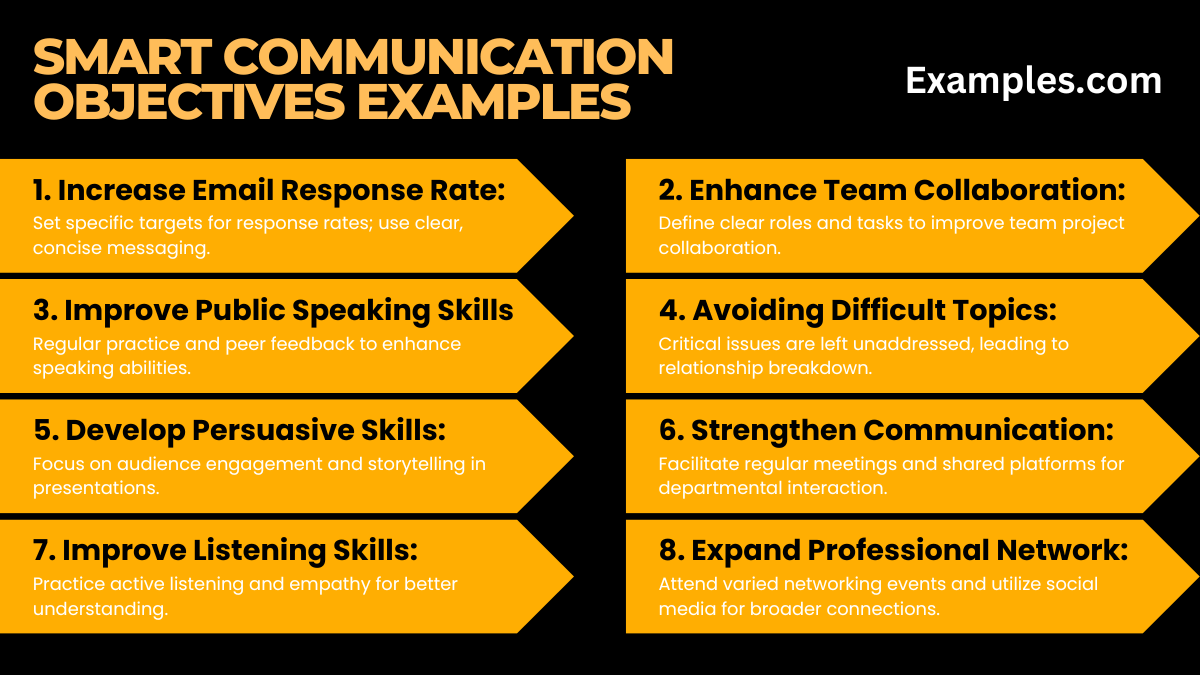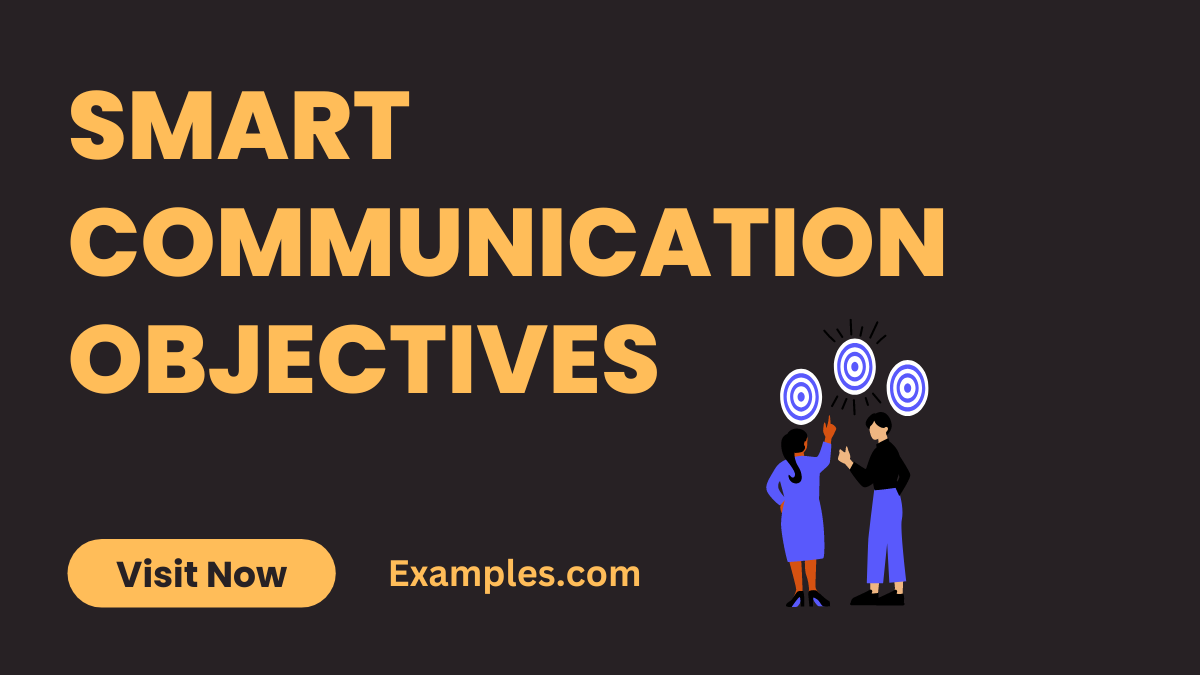9+ Smart Communication Objectives Examples
In today’s fast-paced world, mastering Smart Communication Objectives is crucial for personal and professional growth. This guide delves into the essence of effective communication, providing insightful Communication Examples and strategies. Whether you’re a student, professional, or just keen on improving your communication skills, our guide offers practical examples and tips to make your communication more goal-oriented and impactful.
Download Smart Communication Objective Tracking Sheet Table
Download Communication Objectives PDF
What is Smart Communication Objectives?

Smart strategic Communication Objectives refer to well-defined, strategic goals set for communication that are based on the SMART criteria: Specific, Measurable, Achievable, Relevant, and Time-bound. These objectives ensure that communication efforts are clear, focused, and effective, whether in personal interactions, business environments, or educational settings. By adhering to these criteria, communication becomes more purposeful and aligned with desired outcomes, leading to better understanding, engagement, and success in various endeavors.
What is the Best Example of Smart Communication Objectives?

A standout example of Smart Communication Objectives is Starbucks’ customer engagement strategy. They set specific goals for gathering customer feedback through various channels like social media and mobile apps. These objectives are measurable, tracking customer responses to assess effectiveness. Starbucks ensures their targets are achievable, focusing on enhancing customer experience. They maintain relevance by adapting to consumer trends and set clear, time-bound deadlines for their goals, such as quarterly feedback campaigns. This approach showcases the effective use of SMART principles in communication to bolster customer relationships and business success.
10 Smart Communication Objectives Examples

Each example is crafted to enhance understanding and interaction in various contexts, providing insights into the causes and solutions for common communication challenges. From professional environments to personal interactions, these objectives use the SMART framework to ensure clarity, efficiency, and impact.
- Increase Email Response Rate: Improve your email communication by setting a specific target for response rates. Poor response may be due to unclear messaging. To fix this, use concise language and a clear call to action.
- Enhance Team Collaboration: Aim to increase collaborative efforts in team projects. Often, a lack of collaboration stems from unclear roles. Resolve this by defining specific tasks and responsibilities for each team member.
- Improve Public Speaking Skills: Set a goal to refine public speaking abilities. Anxiety or lack of practice could hinder this skill. Overcome it through regular practice and feedback from peers.
- Boost Customer Service Satisfaction: Strive for higher satisfaction levels in customer service. Misunderstandings or slow response times can be the cause. Address this by training staff in effective communication and empathy.
- Develop Persuasive Presentation Skills: Target the development of persuasive techniques in presentations. Ineffectiveness may arise from a lack of audience engagement. Enhance this by understanding audience needs and incorporating storytelling.
- Strengthen Communication: Focus on improving communication between different departments. Barriers may be due to siloed information. Break these Communication barriers by regular interdepartmental meetings and shared platforms.
- Enhance Social Media Engagement: Set objectives to increase engagement on social media platforms. Low engagement can result from unrelatable content. Fix this by tailoring content to audience preferences and trends.
- Improve Listening Skills: Work on becoming a better listener. Poor listening often comes from distractions or preconceived notions. Improve by practicing active listening and empathy.
- Expand Professional Network: Aim to grow your professional network. A limited network might be due to a narrow focus. Broaden your outreach by attending diverse networking events and using social media.
- Refine Crisis Communication Plans: Ensure crisis communication is clear and effective. Poor handling of crises can stem from lack of preparation. To fix, develop detailed crisis communication strategies and conduct regular drills.
Smart Objectives Communication Skills
These objectives focus on developing clear, effective, and impactful communication abilities. Whether it’s improving verbal articulation or enhancing non-verbal cues, these goals use the SMART criteria to ensure tangible progress in your communication skills.
- Master Active Listening: Concentrate on fully understanding the speaker.
Example: In meetings, summarize what the speaker said to confirm understanding. - Enhance Empathy in Conversations: Aim to understand others’ perspectives better. Example: When someone shares a problem, respond with “I see how that could be challenging for you.”
- Improve Assertiveness: Work on communicating your needs clearly and respectfully. Example: In discussions, state your viewpoint with “I believe…” or “I feel…”
Smart Objectives Communication Plan
Develop a Smart Objectives Communication Plan to streamline and optimize your communication efforts. These plans are essential for ensuring that your communication is strategic, targeted, and effective, whether it’s for a project, a team, or an entire organization.
- Regular Team Updates: Set a schedule for consistent team communication.
Example: Organize weekly briefings to keep everyone informed. - Feedback Loop Implementation: Establish a structured system for feedback.
Example: Introduce monthly feedback sessions with “Let’s discuss what’s working well and what can be improved.” - Enhance Digital Communication Tools: Upgrade tools for better online communication. Example: Propose adopting a new collaboration platform with “This tool can improve our team’s efficiency.”
Smart Objectives Communication Strategy
Creating a Smart Objectives Communication Strategy involves setting precise goals for how an organization communicates internally and externally. These strategies are aimed at improving overall communication effectiveness, clarity, and reach.
- Brand Message Clarity: Focus on making the brand message more distinct.
Example: In campaigns, use “Our brand stands for…” to emphasize unique qualities. - Diverse Audience Engagement: Aim to reach a broader audience spectrum.
Example: “Let’s tailor our message to connect with different demographic groups.” - Crisis Communication Preparedness: Enhance readiness for potential crises.
Example: Develop a crisis plan with “We need a clear protocol for any communication during crises.”
Smart Internal Communication Objectives
Smart Internal Communication Objectives are designed to improve the flow of information within an organization. These objectives aim to enhance transparency, collaboration, and morale among team members.
- Transparency in Decision Making: Promote openness in organizational decisions.
Example: Communicate changes with “We want to explain the rationale behind our decisions.” - Cross-Departmental Collaboration: Foster communication across different departments. Example: Propose inter-departmental meetings with “Regular discussions can align our efforts.”
- Employee Recognition Programs: Implement systems to acknowledge staff achievements. Example: Suggest a recognition program with “Recognizing our peers can boost morale.”
Smart Marketing Communication Objectives Examples
Smart Marketing Communication Objectives Examples focus on setting specific, measurable, and achievable goals for marketing communication. These objectives are tailored to enhance brand awareness, customer engagement, and market reach.
- Increase Social Media Reach: Expand your brand’s social media presence.
Example: “By targeting these platforms, we can broaden our audience.” - Customer Engagement Enhancement: Boost interaction with customers.
Example: “Let’s create more engaging content to connect with our audience.” - Lead Generation via Content Marketing: Use content to generate leads.
Example: “Our blog can be a tool for attracting potential customers.”
SMART Communication Goals and Objectives in Business
SMART Communication Goals and Objectives in Business are vital for ensuring effective and efficient communication within a business environment. These goals focus on improving clarity, ensuring alignment with business objectives, and enhancing overall business performance.
- Alignment with Business Goals: Ensure communication aligns with business objectives. Example: “Our communication should reflect our business goals.”
- Efficient Information Dissemination: Improve how information is shared within the business.
Example: “Streamlining our information channels can increase efficiency.” - Feedback-Driven Improvement: Use feedback to enhance business communication. Example: “Feedback allows us to continuously improve our communication strategies.”
How do you write Smart Communication Objectives?
Writing Smart Communication Objectives involves a strategic approach that aligns with the SMART framework: Specific, Measurable, Achievable, Relevant, and Time-bound. This methodology ensures that your communication goals are clear, attainable, and effective in achieving desired outcomes.
- Be Specific: Clearly define what you aim to achieve with your communication.
For example, instead of a vague goal like “improve team communication,” specify “increase team meeting efficiency by reducing meeting time by 15%.” - Ensure Measurability: Attach quantifiable metrics to track progress. If your objective is to enhance customer engagement, you might measure success by the increase in customer feedback responses.
- Set Achievable Goals: Your objectives should be realistic and attainable within available resources and time constraints. If you’re aiming to improve public speaking skills, consider realistic steps like attending a public speaking workshop or practicing speech delivery weekly.
- Maintain Relevance: Align your communication objectives with broader personal, professional, or organizational goals. For instance, if a company’s aim is to enhance brand awareness, a relevant communication objective could be to increase social media content by 30%.
- Time-Bound Objectives: Assign a clear deadline to your goals. This creates a sense of urgency and helps in timely execution and evaluation.
For example, set a target to implement a new internal communication tool within three months.
How to Write Smart Communication Objectives Goals
Writing Smart Communication Objectives Goals involves a structured approach that aligns with the SMART criteria: Specific, Measurable, Achievable, Relevant, and Time-bound.
- Specific: Clearly define what you want to achieve. For instance, “Improve team communication efficiency by reducing meeting durations.”
- Measurable: Attach quantifiable metrics to track progress.
Example: “Increase customer feedback by 20% within six months.” - Achievable: Ensure the goals are realistic and attainable.
Example: “Attend two professional communication workshops in the next quarter.” - Relevant: Align the objectives with broader goals. If improving customer relations is a priority, a relevant goal might be “Enhance customer service response time by 30%.”
- Time-bound: Set clear deadlines.
Example: “Implement a new digital communication tool across the organization by the end of Q3.”
How to Use Smart Communication Objectives?
Using Smart Communication Objectives effectively means integrating them into your daily communication practices, whether in personal scenarios or within organizational structures.
- Regular Review and Adjustment: Continuously monitor the progress of your communication objectives. Regular reviews help in identifying areas that need adjustment and reinforce the importance of these goals.
- Incorporate into Daily Communication: Integrate your smart objectives into everyday interactions. If one of your goals is to improve active listening, consciously practice this skill in all conversations.
- Training and Development: Invest in training programs or workshops that align with your communication Skills objectives. For enhancing presentation skills, participating in specialized training can be highly beneficial.
- Feedback Mechanism: Establish a feedback system to gauge the effectiveness of your communication strategies. Encourage honest feedback from colleagues, friends, or customers to understand the impact of your communication and areas for improvement.
- Leverage Technology: Utilize technological tools that can aid in achieving your communication goals. For example, use project Management Communication Objectives software to enhance team communication or social media analytics tools to measure engagement.
What are Smart Objectives for Internal Communication?
Smart objectives for internal communication focus on clear, measurable, and achievable goals, such as enhancing transparency, boosting team collaboration, and improving information dissemination efficiency.
How to Make Communication a Smart Goal?
To make communication a smart goal, define specific, measurable outcomes, ensure achievability, align with broader objectives, and set a clear timeline for accomplishment.
To effectively conclude the article on “Smart Communication Objectives,” it is important to emphasize the integral role these objectives play in enhancing both personal and professional communication. By implementing SMART goals—specific, measurable, achievable, relevant, and time-bound objectives—individuals and organizations can significantly improve the effectiveness and clarity of their communication.
Incorporating insights from resources such as the Defense Information School’s article on “Communication Planning Using SMART Objectives” found here and the SBCC Emergency Toolkit’s guidelines on “Identifying a Set of SMART Communication Objectives” can provide readers with additional depth and practical application examples. These external resources offer valuable perspectives and tools for applying SMART communication objectives in various contexts, further enriching the understanding and utility of the concept.



